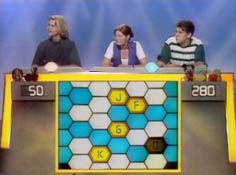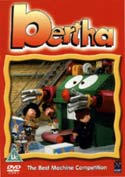Blue Peter

BLUE PETER
Made by: BBC
Shown on: BBC1
Years shown: 1958 - eternity
One of the last remaining true British institutions, Blue Peter launched the concept of the children’s magazine programme, and was first presented by Leila Williams and Christopher Trace, in the late fifties. As generations of children will know, the formula hasn’t changed much. Amongst the presenting line-up there has to be a resilient female, a dependable male, and someone whose job it is to be the resident joker, the one who they send on all the crap outside broadcasts. In what is generally considered the golden era of Blue Peter these roles were filled by Valerie Singleton, Peter Purves and the irrepressible John Noakes (see pic, above.) But no-one is irreplaceable, and children of the eighties will remember some or all of the following, all of whom auditioned interviewing someone while on a trampoline, or that’s what the show would have you believe:
· Simon Groom (1978-86) always seemed like an odd choice for Blue Peter, as to the average viewer he was clearly very old, and - even more apparent - he was very square. He wore bad clothes, had a terribly conservative haircut, and was sole guardian of Goldie, the imaginatively named Blue Peter Golden Labrador. I suspect that he was hired because his parents owned a farm, which had the show’s producers rubbing their hands with glee at the prospect of lots of cheap and educational agricultural features. Groom did have his moment of glory though when, following a piece about the original and replica ornate doorknockers at Durham Cathedral, he declared, “What a fine pair of knockers!” What a card.
· Peter Duncan (1980-84, 85-6) was perhaps an even more dubious choice, considering his past as a soft-porn star. He was the joker in the pack, with a ubiquitous cheeky smile, who wore the same baggy green and white checked suit (designed by a viewer) for about three years. He went on to star in his own spin-off, Duncan Dares, where he would bungee-jump while juggling chainsaws, or something similar.
· Janet Ellis (1983-87) always seemed a bit humourless and no-nonsense, and she seemed to spend a lot of time in casualty. She broke her hip while parachute jumping (the medical intricacies were all explained in great detail in the Blue Peter annual of that year) and suffered an asthma attack while scaling Ayres Rock with Simon Groom. Before Richard Bacon’s gaffe in the nineties, Ellis’ departure was the show’s biggest scandal - she was allegedly forced out because she became pregnant with an ‘illegitimate’ child i.e. she wasn’t married to the father. Now she’s more famous for being the mother of posh pop star Sophie Ellis-Bextor.
· Mark Curry (1986-9) stepped into the role of joker with absolutely zero effort, as this was the trick he’d been peddling on children’s TV for many years. With his ginger hair and zany glasses, he could always be relied upon to slip up, fall into the Blue Peter pond or stand on one of the cats.
· Caron Keating (1986-90), now sadly missed, did her best to drag the style of the show, albeit kicking and screaming, from the eighties and into the nineties. Many a fashion crime was committed in the meantime, as Keating favoured giant red earrings, and yellow and black baggy jumpers. Aside from that, she was just Gloria Hunniford’s daughter.
· Yvette Fielding (1987-92) was an actress who, at 18, became the show’s youngest presenter ever. Much was made of her ‘skin condition’, which she obviously didn’t mind being nationally publicised and discussed. I seem to think that she was very short too, which provided many a comedy camera-angle when trying to film her with the 6ft 4 John Leslie.
· John Leslie (1989-94) fancied himself as a bit rebellious, going as far as to make double-entendres to his female co-hosts, and ending up in the tabloids because of his penchant for ‘the ladies’. He famously dated - and dumped - Catherine Zeta-Jones, in her Darling Buds of May/trying to be a pop star’ phase, but whatever he may say now, everyone knows that he’s kicking himself with those lanky Scottish legs of his.
Some things will always be synonymous with Blue Peter, or BP, as it likes to call itself in an attempt to be hip with the kids, and most of these are responsible for the fact that the programme will never be cool. Every Christmas you are invited to make an Advent Crown out of a pair of coat-hangers and some tinsel, and have to endure the lantern-bearing choir of a local school. Throughout the year there were ideas for low-budget Mother’s Day/Father’s Day/Valentine’s Day presents, usually involving toilet roll tubes, empty Fairy Liquid bottles (with the name and logo painted out), sticky-back plastic, and the infamous double-sided sticky tape, which only the most middle-class and resourceful families would have. Well, Blue Peter was all about being middle-class and resourceful. You could also make Barbie’s bedroom/boudoir/operating theatre using a couple of cereal boxes, and laugh like a loon as the newest presenter managed to adhere a pancake to the studio ceiling on Shrove Tuesday.
Other staples of the show included presenters pretending to like classic cars, strange inventions being demonstrated (including a shed on wheels), birthday cakes being made for - and then rejected by - the snooty Blue Peter pets. The presenters often dressed up as historical figures to commemorate special occasions, or just for the hell of it, and George, the long-suffering tortoise, had to be prepared for hibernation (Unlike the rest of us, he was able to escape Blue Peter for a few months of the year.) Then there was the Blue Peter garden, which was famously vandalised, where you would find Percy Thrower or, later, Claire Bradley, in the greenhouse, or trying to fish something out of the pond (gardening slots were the perfect opportunity for a toilet break.) Competitions also abounded, but they demanded a lot of work, usually designing a safe transportation module for depleted uranium, or solving the Irish Question, but the prizes were pretty good, such as state-of-the-art cameras or computers. And nobody could put a price on the honour of winning a much-coveted Blue Peter badge, which would get you into the Llandudno Pottery Works for half price. My friend won one for being a runner-up in a contest to design a cover for the Radio Times, and I’d like to think she’d bequeath it to me should something nasty befall her.
(Thanks to the British Film Institute website for the borrowed pic)


